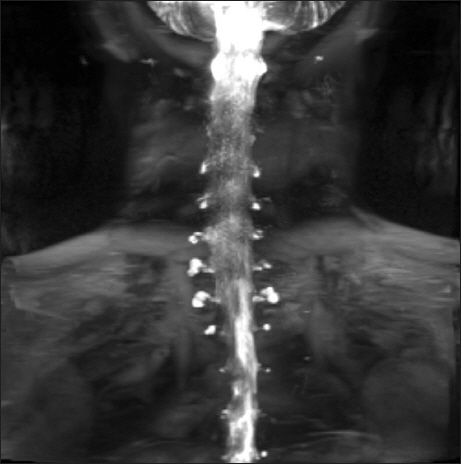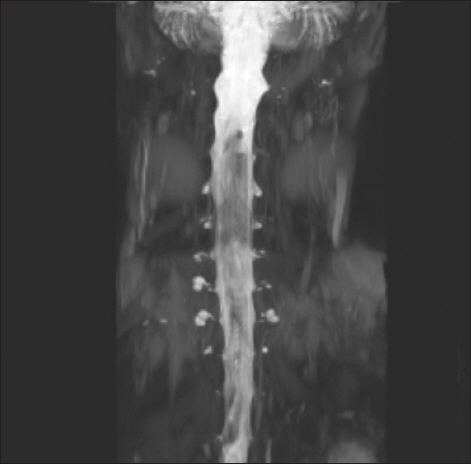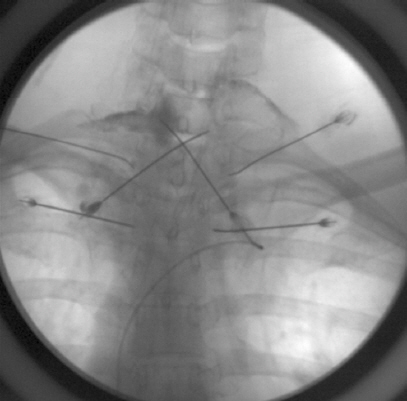Anesth Pain Med.
2019 Jul;14(3):335-340. 10.17085/apm.2019.14.3.335.
Multiple epidural fibrin glue patches in a patient with spontaneous intracranial hypotension:A case report
- Affiliations
-
- 1Department of Anesthesiology and Pain Medicine, Konkuk University School of Medicine, Seoul, Korea. painfree@kuh.ac.kr
- KMID: 2454820
- DOI: http://doi.org/10.17085/apm.2019.14.3.335
Abstract
- BACKGROUND
Spontaneous intracranial hypotension (SIH) is a condition caused by spontaneous leakage of cerebrospinal fluid, with postural headache as the primary symptom. Orthostatic headache caused by SIH is often not resolved by conservative management. CASE: We performed 15 epidural blood patch treatments in a 43-year-old female patient; however, they were only transiently effective. To improve the patient's SIH and orthostatic headache, epidural fibrin glue patch treatment was attempted. Fibrin glue is a substance that can act as a bio-friendly adhesive by facilitating the coagulation cascade. In our case, 3 epidural fibrin glue patch treatments were performed and the symptoms completely resolved.
CONCLUSIONS
The epidural fibrin glue patch may be beneficial for the treatment of refractory postural headaches caused by SIH.
MeSH Terms
Figure
Reference
-
1. Steenerson K, Halker R. A practical approach to the diagnosis of spontaneous intracranial hypotension. Curr Pain Headache Rep. 2015; 19:35. DOI: 10.1007/s11916-015-0509-9. PMID: 26077206.2. Kim SY, Hong JH. Epidural blood patches in a patient with multilevel cerebrospinal fluid leakage that was induced by spontaneous intracranial hypotension. Korean J Pain. 2010; 23:46–50. DOI: 10.3344/kjp.2010.23.1.46. PMID: 20552073. PMCID: PMC2884212.3. Inamasu J, Guiot BH. Intracranial hypotension with spinal pathology. Spine J. 2006; 6:591–9. DOI: 10.1016/j.spinee.2005.12.026. PMID: 16934734.4. Mammis A, Agarwal N, Mogilner AY. Alternative treatment of intracranial hypotension presenting as postdural puncture headaches using epidural fibrin glue patches:two case reports. Int J Neurosci. 2014; 124:863–6. DOI: 10.3109/00207454.2014.880436. PMID: 24397497.5. So Y, Park JM, Lee PM, Kim CL, Lee C, Kim JH. Epidural blood patch for the treatment of spontaneous and iatrogenic orthostatic headache. Pain Physician. 2016; 19:E1115–22.6. Freeman ED, Hoelzer BC, Eldrige JS, Moeschler SM. Fibrin glue to treat spinal fluid leaks associated with intrathecal drug systems. Pain Pract. 2014; 14:570–6. DOI: 10.1111/papr.12151. PMID: 24256213.7. Kamada M, Fujita Y, Ishii R, Endoh S. Spontaneous intracranial hypotension successfully treated by epidural patching with fibrin glue. Headache. 2000; 40:844–7. DOI: 10.1111/j.1526-4610.2000.00153.x. PMID: 11135031.8. Gladstone JP, Nelson K, Patel N, Dodick DW. Spontaneous CSF leak treated with percutaneous CT-guided fibrin glue. Neurology. 2005; 64:1818–9. DOI: 10.1212/01.WNL.0000162029.96759.D2. PMID: 15911828.9. Schievink WI, Maya MM, Moser FM. Treatment of spontaneous intracranial hypotension with percutaneous placement of a fibrin sealant. Report of four cases. J Neurosurg. 2004; 100:1098–100. DOI: 10.3171/jns.2004.100.6.1098. PMID: 15200130.10. Elwood JJ, Dewan M, Smith JM, Mokri B, Mauck WD, Eldrige JS. Efficacy of epidural blood patch with fibrin glue additive in refractory headache due to intracranial hypotension:preliminary report. Springerplus. 2016; 5:317. DOI: 10.1186/s40064-016-1975-1. PMID: 27066348. PMCID: PMC4788675.11. Wong K, Monroe BR. Successful treatment of postdural puncture headache using epidural fibrin glue patch after persistent failure of epidural blood patches. Pain Pract. 2017; 17:956–60. DOI: 10.1111/papr.12541. PMID: 27910226.12. Montana M, Tabélé C, Curti C, Terme T, Rathelot P, Gensollen S, et al. Organic glues or fibrin glues from pooled plasma:efficacy, safety and potential as scaffold delivery systems. J Pharm Pharm Sci. 2012; 15:124–40. DOI: 10.18433/J39K5H. PMID: 22365094.13. Spotnitz WD. Fibrin sealant:past, present, and future:a brief review. World J Surg. 2010; 34:632–4. DOI: 10.1007/s00268-009-0252-7. PMID: 19820991.14. Gerritse BM, van Dongen RT, Crul BJ. Epidural fibrin glue injection stops persistent cerebrospinal fluid leak during long-term intrathecal catheterization. Anesth Analg. 1997; 84:1140–1. DOI: 10.1097/00000539-199705000-00035. PMID: 9141947.
- Full Text Links
- Actions
-
Cited
- CITED
-
- Close
- Share
- Similar articles
-
- Epidural Blood Patches in a Patient With Multi-level Cerebrospinal Fluid Leakage That Was Induced by Spontaneous Intracranial Hypotension
- Spontaneous Intracranial Hypotension and Epidural Blood Patch: A case report
- 10 Times Epidural Blood Patches for Spontaneous Intracranial Hypotension: A case report
- Epidural Blood Patch in Patient with Spontaneous Intracranial Hypotension: A case report
- Spontaneous Intracranial Hypotension Secondary to Lumbar Disc Herniation




